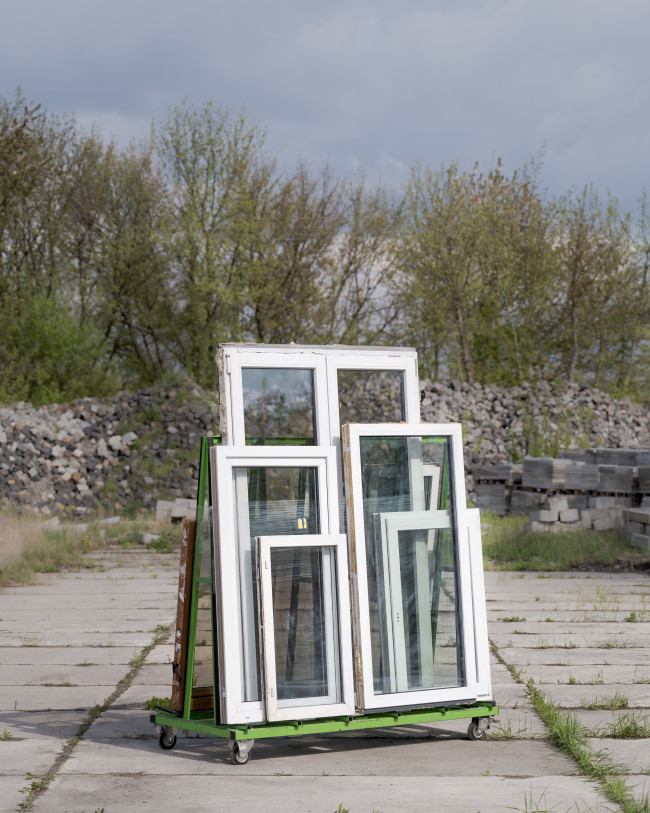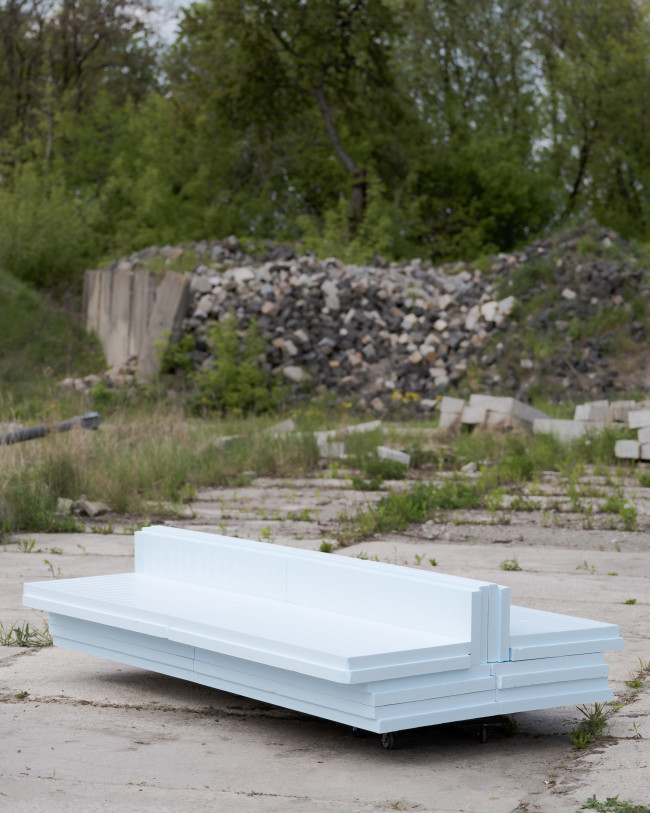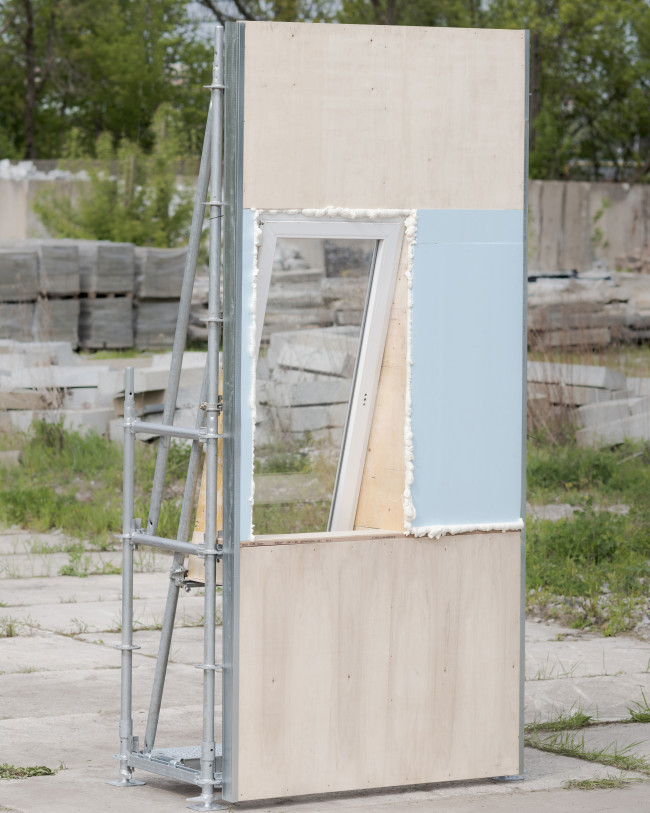Zofia Jaworowska & Michał Sikorski

Text: Maja Von Horn
Photography: Jędrzej Sokołowski
Images no 6-9 were provided by the Adam Mickiewicz Institute
The main prize at this year’s Design Biennale in London went to “Poetics of Necessity,” a Polish pavilion designed by the Warsaw studio TŁO [“Background”] and curated by Zofia Jaworowska, Michał Sikorski, and Petro Vladimirov. The installation showcases the group’s effort to collect windows in Poland and send them to war-torn Ukraine. The humble window becomes a starting point for talking about the concept of reuse in construction, challenging the designer’s ego, and architecture of the future.
M.v.H.: How did you get to be Poland’s representatives at the Design Biennale in London?
Z.J.: We applied and won the competition. Our entry stems from a community effort, which perfectly aligns with the theme of this year’s Biennale, “Remapping Collaborations,” or thinking about how to collaborate within design and architecture in today’s strange, difficult times.
M.S.: The pavilion was inspired by the project “Window” which was created by Zosia and Petro Vladimirov as part of their work for the BRDA foundation. They collect windows and send them to the areas of Ukraine where explosions knocked them out of people’s homes. It also stems from our broader area of interest, which is recycling construction materials and thinking about what kind of architecture and design can that generate in the future.
Z.J.: For the pavilion, we organized a mini drive, collecting about 30 windows which will go from London to Warsaw, and then on to Kyiv.
M.S.: We wanted to take advantage of the opportunity, and instead of just talking about what we do, actually doing it by sending windows we collected from Londoners to the war zone.
Z.J.: It was a difficult undertaking, because British windows are different from Polish ones, they usually open top to bottom, and not out. The quality of English carpentry is also much worse than what we’re used to in Poland, most of the windows are very old.
M.v.H.: What did “collecting” windows from Londoners look like?
Z.J.: First we reached out to manufacturers, but it quickly turned out that it was not the best strategy. Then we started looking for posts from people who were selling old windows on online forums like Gumtree. We would try to convince them to give the windows away for free to send to Ukraine. We got a lot of positive reactions.
M.v.H.: You called the pavilion “Poetics of Necessity.” What does it look like?
M.S.: We have two rooms – sitting rooms with fireplaces – in the historic Somerset House. In the first room, which we’ve called “Resourcing,” we symbolically recreate a storage facility for the collected windows, and describe how Zosia and Petro organize the drives in Warsaw. We’ve called the second room “Homecoming,” because it is a story about how the windows are used when they arrive in Ukrainian homes. In this room we also screen a beautiful film that shows how the windows are installed, but also images of the war’s devastation. We also have a life-size mock-up in which we showcase one of the unusual ways of window installation that wartime conditions might require, for example on the last floor of an apartment building without any sort of scaffolding. You can look at it while sitting on a couch that we’ve constructed from Styrodur, a very pedestrian construction material. The couch was also created in the spirit of reuse, because the panels we used to build it can be later recycled as a wall isolation layer. The idea is to promote zero waste in architecture.
Z.J.: There are two aspects to our story: there’s the societal layer, around the use of recycled materials, and the technical layer. We weave these two strains together in our pavilion. We’ve also created an exhibition catalog devoted more broadly to the topic of recycled materials and the fact that they could play an important societal role.
The Polish pavilion at the London Design Biennale was produced by the Adam Mickiewicz Institute. The Institute holds competitions to select the pavilion design to represent Poland. The jury includes members of design and architecture-related institutions.
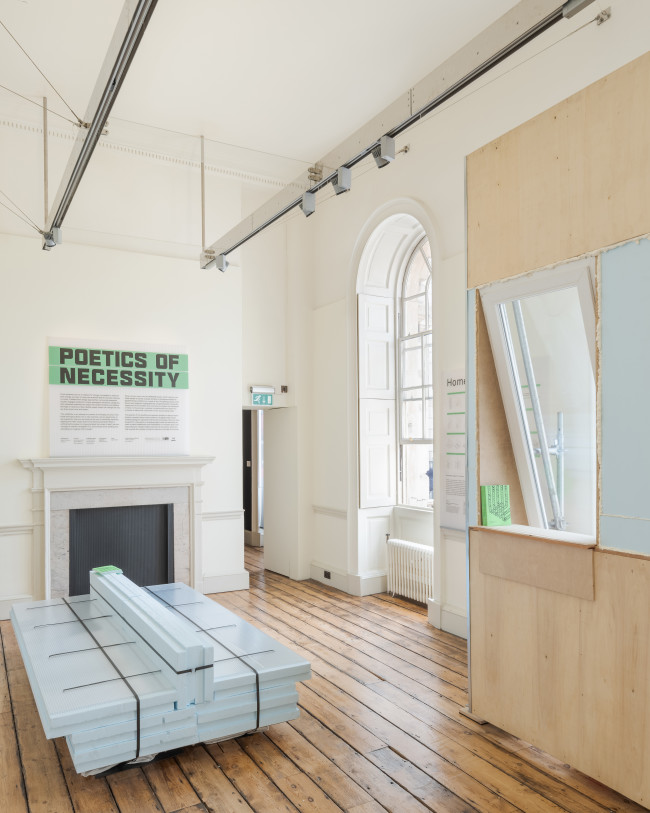
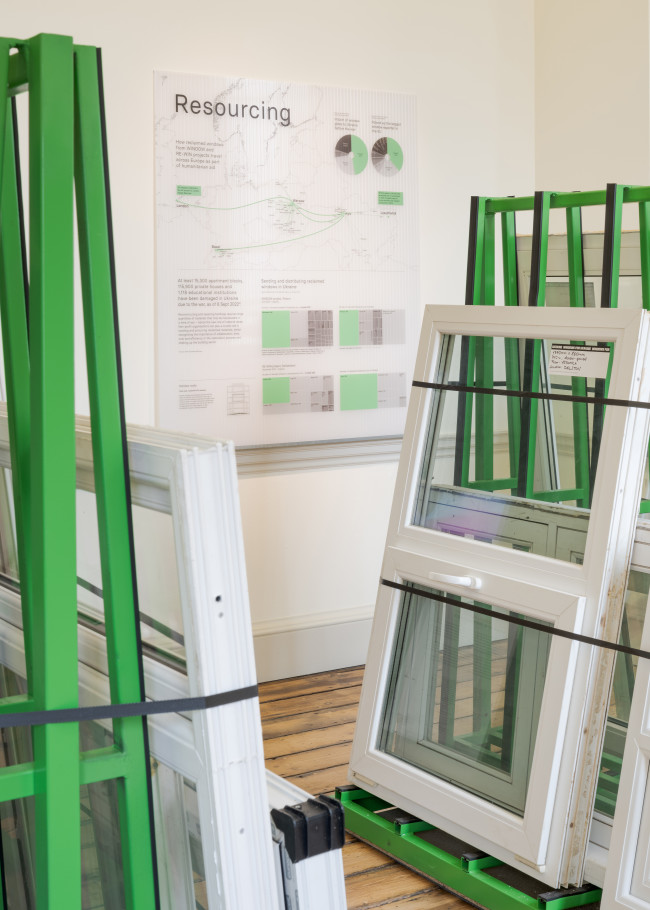
M.v.H.: In fashion, design, architecture, and many other industries the topic of circularity has been around for a long time, but it seems to be a relatively new conversation within architecture.
M.S.: A new and very important one, because there aren’t many ways to limit the carbon footprint of what we build. One of those ways is to reuse materials that have already been produced.
Z.J.: It’s not entirely a new phenomenon. Take, for instance, the fact that Warsaw was rebuilt from its own rubble after the war. I think that’s probably the best example of reuse out there, because they retrieved incredible quantities of material – largely bricks – from the rubble. They mixed it with concrete, which allowed the rebuilding of entire modernist neighborhoods in Warsaw in the 1950s.
M.S.: The idea may not be new, but there’s a variety of new methods of using recycled construction materials. But it’s complicated, mostly because of regulatory reasons. Because of liability issues it’s not easy, especially in any government buildings or public housing, to get permits to use recycled materials. But in my architecture studio Tło we do experiment with them. In one of our designs we’re incorporating recovered stone for the floor, and in another we’re building from recycled concrete blocks.
Z.J.: It’s easier to implement in smaller, private projects where there are fewer interests to consider than in a large commercial or public-use building.
M.S.: For the catalog, we spoke with pioneers of the reuse movement in architecture, such as the visionary Swiss architect Barbara Buser, who over the course of several decades developed a number of methods for how to effectively use recycled materials in construction. A giant explosion that in 2020 rocked a port in Beirut blew out the windows in buildings within a 10 km radius. That was when another incredible woman, Lara Moutin, who is French, organized a window collection drive. For us, it’s important to come up with efficient processes so that when there’s a crisis, we don’t have to start everything from scratch.
Z.J.: It turns out that intuitive reactions to a crisis are actually quite similar across the world. Barbara Buser is also sending windows to Ukraine, from Switzerland. At first, our methods were completely different, not unlike Polish and Swiss temperaments. They did everything meticulously, we just packed in as many windows as we could, not paying attention to whether the windows were, for example, clean or not. Now, after a year of doing this, I think our methods have balanced out and are quite similar. Both us and the Swiss have sent about 1200 windows to Ukraine.
M.v.H.: How did the idea of crowdsourcing windows come about?
Z.J.: I’ve been active in the housing space and refugee aid in Poland for a while. I was trying to figure out how to do it in a more formalized way, how to help with war relief beyond Poland, in Ukraine itself. We concluded that windows are the most immediate need in the grassroots rebuilding efforts, and we identified the NGOs and various initiatives that are active in this space in Ukraine. Windows are extremely expensive and difficult to source because 80 percent of the raw glass in Ukraine came from Belarus and Russia. So we started collecting window frames in Poland, by driving a delivery van with a trailer around the country and grabbing any old, but still functional windows that people have laying around, and sending them to Kyiv. The Ukrainian foundation District One distributes them locally, publishing a list of the available windows and their dimensions, so that everyone can reserve what they need. In the meantime, we’ve been learning how to install conveyor belts, unscrew window knobs etc. With every transport we get better. [Warsaw] gave us a storage facility to use. We recently picked up 200 windows and frames left over from a hospital renovation in [the Polish city of] Opole. We were also able to get 215 windows from the iconic 1990s Atrium office building in Warsaw. Those windows are pink, and they went to the village of Kamyanka, by Izium. But even though these mass donations are the cheapest, easiest, and most efficient, the civic aspect of all of this is very important to me – it’s crucial to get regular people involved, not just companies.
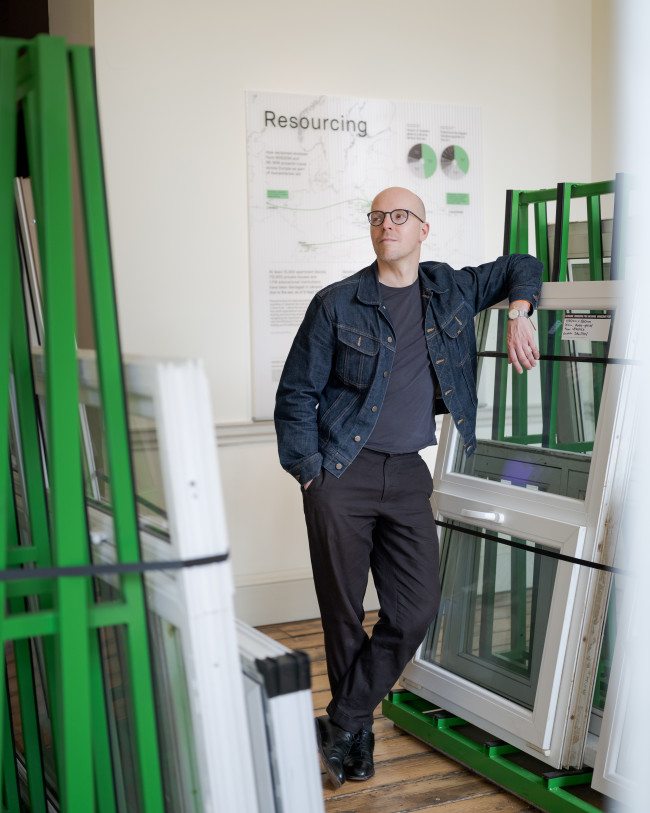
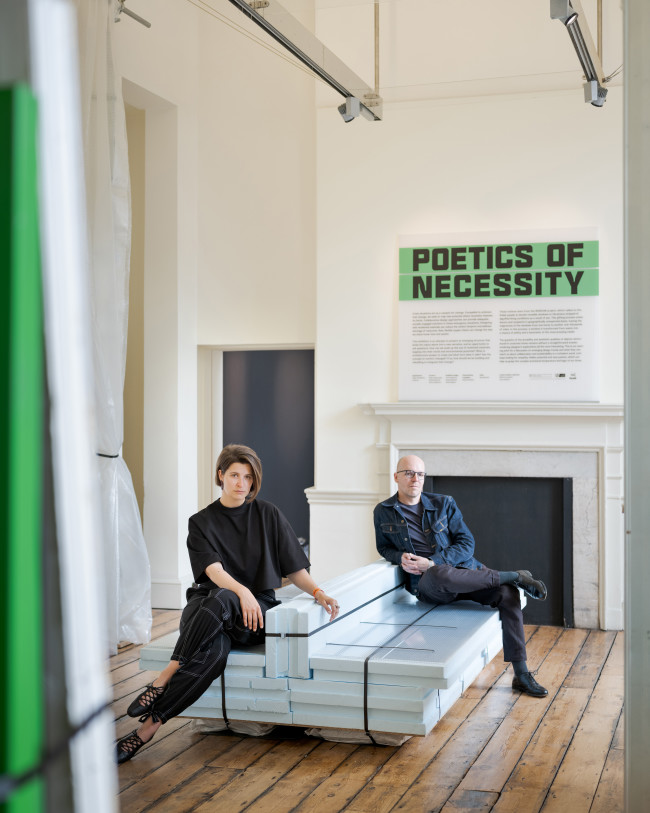
M.v.H.:: And what happens when the window and the wall opening don’t have the same dimensions?
M.S.: That’s almost always the case. When in November we led an architectural workshop for students as part of the Lower Silesia Architecture Festival in Wrocław, we had some windows with us and asked the students precisely that question: What do you do when the window is too small or too large for the opening?
Usually, during such workshops, students are required to reinvent the wheel, and we did something different by giving them a pretty boring task that focused on construction detail. It turned out that their ideas were fascinating, and it was a very inspiring experience. We’ll be presenting the most interesting proposal, a system of diagonal installation, in our pavilion at the Design Biennale in London.
M.v.H.:: How do you diagonally install a window?!
M.S.: Imagine that you live on the eighth floor of an apartment building and your window falls out. You get one that is too big, plus, in order to install it you have to build a scaffolding which, in wartime conditions, is basically impossible. What you can do is take planks and wooden panels and install the window from the inside, creating a little bonus shelf in the process. It’s not a perfect solution construction-wise, but it shows that in times of crisis the meaning of comfort and technical excellence is fluid. A DIY window can be the reason for why someone can still live in their house. Along with the BRDA foundation we’ve invited a number of young architects to prepare self-installation instruction booklets – kind of like the ones you get with IKEA furniture – which have been translated into Ukrainian and which we send along with the windows.
M.v.H.:: Will the architecture of the future be not only sustainable, socially conscious, but also generate new aesthetic qualities?
M.S.: Definitely. The more we use recycled construction materials, the more we will have to accept an element of the unknown in the design process. There are some factors we won’t be able to control – recycled materials might have to be of a different color or have different dimensions than what we initially foresaw.
M.v.H.:: Is it a matter of changing your priorities?
M.S.: Absolutely. The younger generation of architecture students is very open to this. The archetype of the modernist architect – which is nearly a hundred years old – who pours out layers and layers of concrete until he achieves his desired color, won’t be the only role model around.
Using found elements or ones that have been designed by other architects won’t mean that the design won’t be interesting or beautiful, it will just mean that the beauty will be different. This idea has been around in interior design for a long time in the form of mixing vintage and contemporary furniture.
Z.J.: It will also require a lot of legislative changes.
M.S.: And an adjustment in the designer’s ego.
Z.J.: The EU is already in the process of establishing norms regulating the carbon footprint of new buildings, and the amount of recycled materials required in new construction – though it will still be 10-15 years before we see those buildings.
M.S.: This is an enormous change and a definite step forward. We will be building from materials that have a low carbon footprint – so first and foremost, wood and stone. In France they are already constructing apartment buildings from solid stone. The next change will be designing in a way that will allow for easily repurposing existing structures, so that we avoid situations like we see today, when providing shelter for refugees in an empty office building is a significant challenge because the windows don’t open. While designing for the future, we ‘re also thinking about how to make a building’s potential demolition more efficient. Our studio tries to design in a responsible way, thinking not only about the investor, but also about the broader urban context.
M.v.H.: Zofia, before you came up with project WINDOW and founded the BRDA foundation, you had also launched the dynamic but short-lived “Grupa Zasoby” [“Project Resources”].
Z.J.: It seemed to me that people were organizing tons of conferences and workshops where the aim was to exchange best practices. This kind of work is much-needed, of course, but I prefer more hands-on activity, something tangible, where you can quantify how many people you were able to help, that you can scale up for larger areas, or replicate elsewhere, by other organizations, in different cities. That’s what happened with “Zasoby.”
M.v.H.: You created the group right after the war erupted.
Z.J.: Yes, that same day I organized at my place a meeting for people that I knew would also feel the need to help. I made an Excel spreadsheet “What resources do you have?” where you could input that you had a big car, or vacant rooms in your hotel, or a large sum of money. The next day we set up at the train station and started finding housing for the incoming refugees. We found dozens of accommodations, so we had to come up with a system that would bring everything together. A friend and his IT team built us – pro bono – a simple online app that allowed for matching people seeking accommodations with people who could offer them. We helped a total of 6,500 people, and our top host took in a total of 80 guests in her four-room apartment, one group after the other, everyone staying several days.
M.v.H.: Why did you suspend the group’s activities, if it was going so well?
Z.J.: By that point, the biggest influx of people had receded, and there were more and more people looking for more long-term housing. We were responding to a crisis situation, whereas long-term solutions should be the realm of the government. Groups such as ours can’t be doing their job.
M.v.H.: You channeled that energy into launching the BRDA foundation.
Z.J.: I like to be involved. Even when I’m doing my creative projects (translation, film), I’m always also working in some sort of foundation at the same time.
M.v.H.: What are your further plans for BRDA?
Z.J.: The most intense push for supporting organizations that are providing aid to Ukraine has passed. There still are companies and individuals that help us financially, but the end goal is to fund the foundation on our own, expanding from windows to other recycled construction elements, part of which we’d sell.
M.S.: We don’t care if we’re revolutionary, or ahead of the curve. We’d be happy if manufacturing furniture or clothing that you don’t have to throw out after several years, or the idea of utilizing space in already existing buildings became more widespread. Before we build something new, let’s fix and use what we have. And where we’re building something new, let’s try to do it in a durable way and by using found elements. Reuse is the future of architecture.
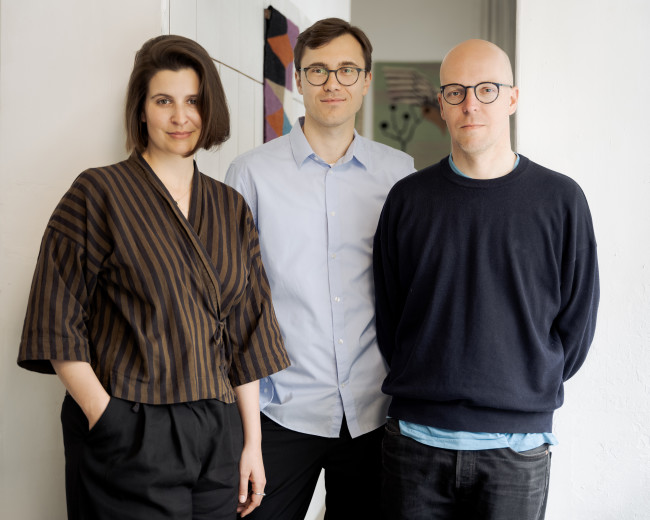
As part of project WINDOW, BRDA Foundation is collecting reclaimed windows and shipping them to non-profit organizations in Ukraine working on rebuilding bombed homes.

